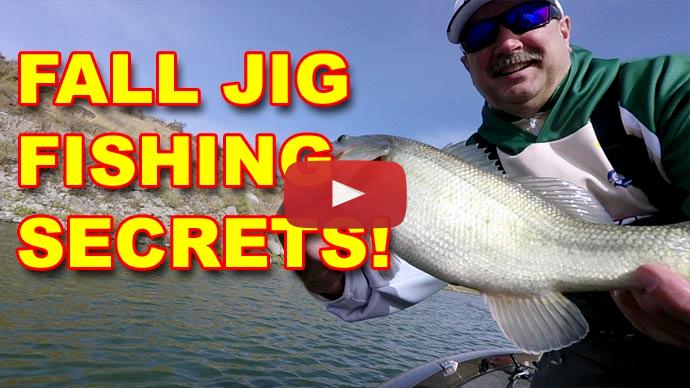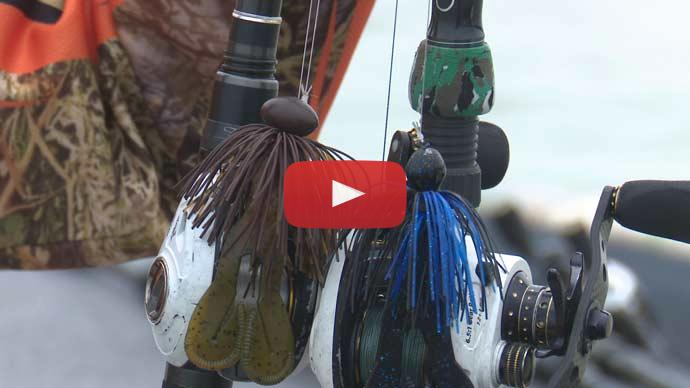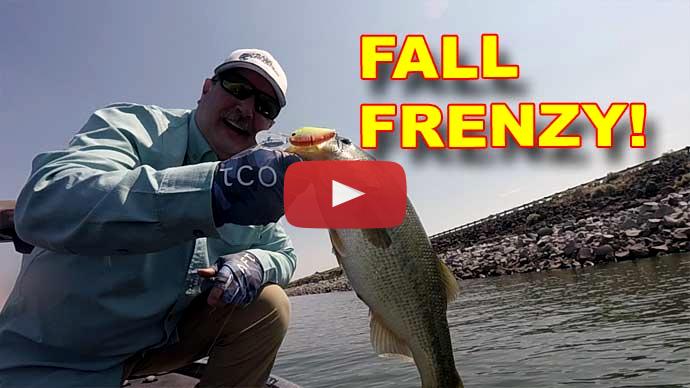So again, following along with our seasonal jig fishing, let's talk fall of the year. And depending on what part of the country that you live in, man, the fall can be probably, honestly, one of the funnest times to fish, because to me, it's funny, but a guy that I grew up with fishing with, an older gentleman was in the bass club with me, called it the Mexican spawn. I don't know why he referred to it as that, but he was like, "Man, in that fall time of the year, once you get..." And I'm talking about fall. Once with the leaves start changing and falling off the trees, and the water temperature starts falling, and fish start to migrate again, especially on shallow water fisheries, those fish would have a tendency to go back and get on the exact same cover that they do pre-spawn.
So especially if you're a river fisherman, or you grew up in a part of the country where, again, you got cypress trees, you got cover, those fish are aggressive, and they started to move back on that same cover again. They'll start to get back on boat docks. That dog days of summer is probably...that period to me is one of the toughest times of the year to fish when you got fish either swimming around out in the abyss on nothing, or you got them up chasing bluegill down the bank. But when we get back into that fall period and you feel that coolness, it's the way you feel in the spring. It gives you that same feeling it gives them. But the main thing with them it does, is that water temperature starts to fall, it triggers them to feed. Because basically they know winter's coming. The cool thing about that is it has that effect. So they feed big when it warms up in the spring before they spawn, and then they feed big again. Because they've probably been a little run down in the summer because of that hot water, and in the fall they've started to...they're hungry again.
But the one thing you have to deal with in the fall is the same thing you dealt with in the spring, is cold fronts. And I find that in the fall of the year, they're not as effective as negatively as they are in the spring. To me, cold fronts in the spring make fish harder to catch. In the fall, it kind of has that reverse deal. I don't like those warm Indian summer days in the fall, I like those cold front days when it is cooler. Because it's like that cool water is triggering them to feed. But what you do have in the fall is you have aggressive fish. A lot of times, especially like reservoir, like we're on here today, you have fish that have been swimming around brush all summer, suspended, out on bait or that kind of stuff. But what happens in the fall? They start to get back on it. And then we can go back to target them with that jig again.
And again, I don't necessarily use as heavy a weight jig in the fall. If I'm using one ounce jig to fish that structure in the summer, in the fall I use a three quarter if that makes sense. Or if I was using a three quarter to pitch around shallow or cover, I might drop back to a half. I slow everything down slightly in the fall from the summer, but not to the point of what we're gonna do in the winter. We're gonna slow back a little bit. Chances are in the fall, I'm still gonna stick with that Rage Craw trailer because I like that swimming action. And it just triggers bites. That Rage Craw basically, you can just throw your jig out there and it'll bite it. Because it's doing its own action. And it's swimming that jig around. I feel like in the fall again, because there's a little bit of that bait fish orientation going on, but the main thing about the fall is they're going back and getting on cover. So now we can pinpoint them and target them.
Probably my least favorite time to fish for them is when they're swimming around in the abyss. I do not like to fish like that. I am a cover oriented fisherman. And that fall period of time is letting me do that again. Like I said, whether I'm on the reservoir, I can target them with brush piles or if I'm at home, I can go back to flipping the outside edge of weeds. So let me go through this scenario. So at home, in the hot part of the summertime where I live at, there is so much matted vegetation and those fish want to be extremely shallow. A lot of times what happens, they basically got so far back out under that stuff, it makes them hard to fish for. And you can only target them places with current and that kind of deal. In the fall, what happens is we still have all that vegetation, but they move to the edge because they're there to feed. So now they've made it where I can get to them again. Again, they've made it where I can target them with that jig.
And again, I'm just basically using...if I had been fishing that stuff with a one ounce in the summer and I'm just backing down to a three quarter, or if I was using a three quarter, I'm going to a half. But we're fishing more edges. We don't have to fish in the middle of the brush, we fish around the edge of it. But we still want that bigger jig because we want that jig to race down there. Here again, I'd use this lake as an example, a lot of spotted bass. And those spotted bass just in the fall just start to get to that cover. And once they do that, we can target them. If it's a lowland reservoir with boat docks, they start to suck to that boat dock again. It's so funny that when the water is extremely hot, that how much time they spend away from everything, getting away from cover. But in the fall as it cools back down, and there is a lot of cover in the fall because we've not had enough cold weather to kill any vegetation, but they start to migrate back to that stuff. And we can pinpoint them. And we can fish for bigger ones. And we can fish really efficiently. Now depending on the lake again, we can be flipping or we can be swimming a jig in the fall.
And depending on if it's a...it could even be a shad deal around the grass in the fall because another thing that happens in the fall of the year, shad also migrate. They start to move up shallower. And when you got a lake that has a lot of shallow vegetation, those shad will have a tendency to move up there. And we can go back to swimming a jig. We can use a white one. Again, it makes us efficient. But fall of the year, just think about it as a faster pre-spawn time. Like again, you have a lot more cover, but those fish are starting to relate. They're starting to get on that stuff that, again, they'll get on again pre-spawn and they're feeding. Another thing that happens, a lot of grass starts to die out that time of the year. Lakes that have had matted mill full all that time of the year, will have a tendency that mill full will start to see, to die out because basically it seeded itself back for the next year and it goes away. And what that does is confine the bluegill. And you've had big mats of vegetation and you got boat docks and all that vegetation goes away. Those bluegill will start getting on whatever covers left. And when they do, those big large mouth and other bass are going there too. They're going wherever the bait is. Everybody's got their feed bag on that time of the year.
Again, probably, that time of the year, more so fishing a jig, not that looks like a crawfish. I'm fishing one green pumpkins, something that looks like a bluegill. I'm matching the trailer to it and that's what I want it to look like in the fall. But just think about it like that, like pre-spawn reverse. Like we're able to use bigger jigs that time of the year and what we're targeting a lot of that heavy cover that's just outside of those spawning areas. Because those fish just have a tendency to want to make that move. Maybe not as far back as they're going in the pre-spawn. But they're moving up. They're moving up shallow where we can target again. One of my favorite things to do, you'll have a lot of lakes that time of the year, you have a lot of low water. And what it'll do is you'll go the backs of creeks and pockets and it'll expose wood, isolated pieces of wood on flat. And you know, you have days when those fish are chasing...in the fall they're chasing bait and you have that cold front come through, and they'll come right back and park on that cover. And then I can target them with a jig.
Typically they're the bigger ones. They're not those little schoolers that were out there running shad. You know, those fish that are getting on that cover, they're more quality fish. But that's a great time of the year to fish. Isolated cover on flats that time of the year. I'd just be running down the lake and there's one big log out there sticking up on the flat. Don't never run past that in the fall. That is about the keyest place you can find in that time of the year. And I can ride up there and pitch that jig on. And again, like after a cold front, they have a tendency, they still wanna be around cover and we can target them with a jig. But that's fall bass fishing, with a jig. They go back to get on those cypress trees again, on those oxbows. What I like about it is kinda that deal where I feel like I have confidence going back and fishing what looks good. You know, visually with my eyes. I'm seeing stuff with my eyes and they're getting back on it in the fall of the year.
That's fall jig fishing. And I love that jig with a rattle on that time of the year because we're fishing a lot of isolated cover depending on where you are. We're not necessarily targeting mats or heavy cover. We need that hack at that jig. But it's another one of those times of the year I feel like that rattle will get you some bites. But that's fall bass fishing with a jig and I hope that gets you a few more bites this fall.



